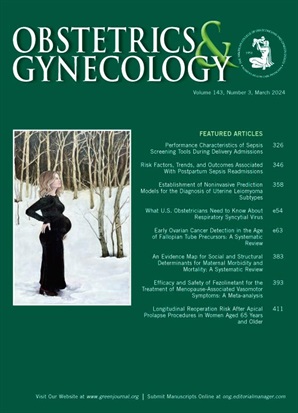留胎治疗胎盘增生谱系障碍。
IF 5.7
2区 医学
Q1 OBSTETRICS & GYNECOLOGY
引用次数: 0
摘要
目的根据计划的手术处理方法,评价留置胎盘进行胎盘增生谱(PAS)的产妇结局。方法对2015年1月至2024年10月采用胎盘原位置换术治疗的PAS患者进行单中心回顾性队列研究。在我们的中心,除了剖宫产子宫切除术外,患者还可以选择其他治疗PAS的方法。这些方法包括将胎盘留在原位进行计划的子宫保存或计划的延迟子宫切除术。我们分析了保留胎盘的产妇结局,包括感染的风险、导致子宫切除术的严重出血、输血率和严重的产妇发病率。我们还根据计划手术(子宫保留或延迟子宫切除术)和最终手术(子宫保留成功或间隔子宫切除术)分析了结果。结果180例产前诊断为PAS的患者中,50例计划保留胎盘,7例(14%)因产前或术中出血行剖宫产子宫切除术,43例(86%)采用保留胎盘。在43例保留胎盘的患者中,5例(12%)因出血需要子宫切除术,4例(9%)患有子宫内膜炎。没有静脉血栓栓塞或产妇死亡病例。29例患者计划保留子宫,14例患者计划延迟子宫切除术。在29例计划保留子宫的患者中,13例(45%)成功,中位排出或吸收时间为17周,16例(55%)行间歇子宫切除术(9/16指征,7/16患者要求)。根据最终执行的手术,与最终接受间隔子宫切除术的30例患者相比,成功保存子宫的患者(n=13)的中位数估计总失血量(700 mL对1,950 mL, P< 0.01),输血率(31%对73%,P< 0.01)和输血超过4个单位(8%对47%,P= 0.01)更低。5名患者随后怀孕,没有前置胎盘或PAS。当通过计划手术(计划子宫保留与计划间隔子宫切除术)进行分析时,在中位估计总失血量、输血率和输血超过4个单位方面没有差异。结论:大多数采用胎盘原位保留治疗的PAS患者没有出现感染或出血并发症,无需子宫切除术。对于那些希望保留子宫的患者,或者那些患有PAS的患者,如果进行剖宫产子宫切除术,可能会出现危及生命的出血,将胎盘留在原位可能是剖宫产子宫切除术的合适选择。考虑到样本量小,这些结果应该谨慎解释,这可能会排除罕见但潜在严重并发症的检测。本文章由计算机程序翻译,如有差异,请以英文原文为准。
Leaving Placenta In Situ for Management of Placenta Accreta Spectrum Disorder.
OBJECTIVE
To evaluate maternal outcomes when leaving the placenta in situ for placenta accreta spectrum (PAS) according to planned surgical management.
METHODS
We conducted a single-center retrospective cohort study of patients with PAS managed by leaving the placenta in situ from January 2015 to October 2024. At our center, patients are given options other than cesarean hysterectomy for the management of PAS. These include leaving the placenta in situ for either planned uterine preservation or planned delayed hysterectomy. We analyzed maternal outcomes with leaving the placenta in situ, including risk of infection, significant bleeding resulting in hysterectomy, blood transfusion rates, and serious maternal morbidity. We also analyzed outcomes according to planned procedure (uterine preservation or delayed hysterectomy) and final procedure performed (successful uterine preservation or interval hysterectomy).
RESULTS
Of 180 patients with antenatal diagnosis of PAS, 50 were planned for leaving the placenta in situ: seven (14%) underwent cesarean hysterectomy because of antepartum or intraoperative hemorrhage, and 43 (86%) were managed by leaving the placenta in situ. In the 43 managed with leaving the placenta in situ, five (12%) had bleeding necessitating a hysterectomy, and four (9%) had endometritis. There were no cases of venous thromboembolism or maternal death. Twenty-nine patients were planned for uterine preservation, and 14 were planned for delayed hysterectomy. Among the 29 patients planned for uterine preservation, 13 (45%) were successful, with median time to expulsion or resorption of 17 weeks, and 16 (55%) underwent interval hysterectomy (9/16 indicated and 7/16 patient request). According to the final procedure performed, compared with the 30 patients who ultimately underwent an interval hysterectomy, those with successful uterine preservation (n=13) had lower median estimated total blood loss (700 mL vs 1,950 mL, P<.01), blood transfusion rates (31% vs 73%, P<.01), and blood transfusion exceeding 4 units (8% vs 47%, P=.01). Five patients had subsequent pregnancies, with no placenta previa or PAS. When analyses were conducted by planned procedure (planned uterine preservation vs planned interval hysterectomy), there were no differences in median estimated total blood loss, blood transfusion rates, and blood transfusion exceeding 4 units.
CONCLUSION
The majority of patients with PAS who were managed by leaving the placenta in situ did not experience complications of infection or bleeding necessitating hysterectomy. Leaving placenta in situ may be appropriate to offer as an alternative to cesarean hysterectomy in those desiring uterine preservation or those who have PAS with concern for life-threatening bleeding if cesarean hysterectomy is performed. These results should be interpreted with caution given the small sample size, which could preclude detection of rare but potentially serious complications.
求助全文
通过发布文献求助,成功后即可免费获取论文全文。
去求助
来源期刊

Obstetrics and gynecology
医学-妇产科学
CiteScore
11.10
自引率
4.20%
发文量
867
审稿时长
1 months
期刊介绍:
"Obstetrics & Gynecology," affectionately known as "The Green Journal," is the official publication of the American College of Obstetricians and Gynecologists (ACOG). Since its inception in 1953, the journal has been dedicated to advancing the clinical practice of obstetrics and gynecology, as well as related fields. The journal's mission is to promote excellence in these areas by publishing a diverse range of articles that cover translational and clinical topics.
"Obstetrics & Gynecology" provides a platform for the dissemination of evidence-based research, clinical guidelines, and expert opinions that are essential for the continuous improvement of women's health care. The journal's content is designed to inform and educate obstetricians, gynecologists, and other healthcare professionals, ensuring that they stay abreast of the latest developments and best practices in their field.
 求助内容:
求助内容: 应助结果提醒方式:
应助结果提醒方式:


